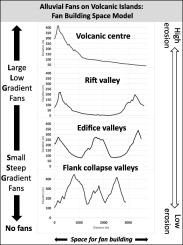当前位置:
X-MOL 学术
›
Geomorphology
›
论文详情
Our official English website, www.x-mol.net, welcomes your
feedback! (Note: you will need to create a separate account there.)
Alluvial fans on volcanic islands: A morphometric perspective (São Vicente, Cape Verde)
Geomorphology ( IF 3.1 ) Pub Date : 2020-11-01 , DOI: 10.1016/j.geomorph.2020.107356 Martin Stokes , Alberto Gomes
Geomorphology ( IF 3.1 ) Pub Date : 2020-11-01 , DOI: 10.1016/j.geomorph.2020.107356 Martin Stokes , Alberto Gomes

|
Abstract The distribution, morphology and development of volcanic island alluvial fans are investigated using Sao Vicente from the Cape Verde volcanic chain (east-central Atlantic Ocean). This is a tectonically and volcanically inactive dryland setting, comprising an eroded Plio-Pleistocene composite volcano overlying a submarine shield volcano. We mapped 228 alluvial fans, quantifying fan (F) and catchment (C) morphological properties (area [A], gradient [G], relief [R], length [L]). Fans and catchments of varying size and gradient are distributed around the island coastal margins (6%) and along interior valley sides (94%). Regression results (i.e. +ve/−ve slopes of best fit lines) conformed to broader fan research but with weak correlations, and coefficient-exponent values outside, or at the lower end of values reported from non-volcanic settings. Analysis of fan area and gradient vs catchment area regression residuals revealed fans were dominated by small-steep gradient (28%) and large-low gradient forms (39%). Fan building space is a fundamental control, specifically linked to volcano structure, but with interplay between rock strength, base level, and climate. Fans around the volcanic edifice flanks are uncommon due to steep flank slopes. Where flank margin fans occur they are typically small and steep forms due to marine erosion. Fans along flank incised valleys are common. Large low gradient fans are associated with a major volcanic rift-aligned valley structure, with extensive erosion into altered and weathered edifice-core lithologies. Small-steep gradient fans are associated with edifice flank valleys. Steeper and narrower valley forms reflect incision into stronger lithologies of the composite volcano flanks, restricting fan building space. Fans located within the volcano central depression are amongst the largest and lowest gradient types, building into the eroded and unconfined edifice core space. Coalescence, apex-toe incision, toe erosion and catchment stream channel backfilling displayed by most fans suggest landscape erosion dominates during more arid periods (e.g. interglacials), with the dryland setting generating limited sediment and insufficient flood runoff for transport and fan deposition. Fan building likely occurs during wetter periods linked to Quaternary climate variability. Quaternary eustatic variations are relevant for the volcano edifice margins where sea level changes control fan building space and erosion.
中文翻译:

火山岛上的冲积扇:形态测量视角(佛得角圣维森特)
摘要 以佛得角火山链(大西洋中东部)的圣维森特为研究对象,研究了火山岛冲积扇的分布、形态和发育。这是一个构造和火山不活跃的旱地环境,包括一个被侵蚀的上新世-更新世复合火山,覆盖在海底盾状火山上。我们绘制了 228 个冲积扇,量化了扇 (F) 和集水区 (C) 的形态特性(面积 [A]、梯度 [G]、地势 [R]、长度 [L])。不同大小和坡度的风扇和集水区分布在岛屿沿海边缘 (6%) 和内部山谷两侧 (94%)。回归结果(即最佳拟合线的 +ve/-ve 斜率)符合更广泛的风扇研究,但相关性较弱,并且系数指数值在外,或在非火山环境报告的值的下限。扇面积和梯度与汇水面积回归残差的分析显示扇以小陡坡 (28%) 和大低坡 (39%) 形式为主。风扇建筑空间是一个基本控制,特别与火山结构相关,但与岩石强度、基础水平和气候之间的相互作用。由于陡峭的侧翼斜坡,火山大厦侧翼周围的风扇并不常见。在出现侧缘扇的地方,由于海蚀,它们通常是小而陡峭的形式。沿侧切谷的扇形很常见。大型低梯度扇与主要的火山裂谷对齐的山谷结构有关,广泛侵蚀成蚀变和风化的建筑物核心岩性。小陡坡风扇与建筑物侧翼山谷有关。更陡和更窄的山谷形态反映了对复合火山侧翼更强岩性的切割,限制了扇形建筑空间。位于火山中央凹陷内的风扇是最大和最低梯度类型之一,构建在侵蚀和无约束的大厦核心空间中。大多数风扇显示的聚结、尖尖切口、尖角侵蚀和集水河道回填表明,在更干旱的时期(例如间冰期),景观侵蚀占主导地位,旱地环境产生的沉积物有限,洪水径流不足以进行运输和风扇沉积。风扇建造可能发生在与第四纪气候变异相关的潮湿时期。第四纪eustatic 变化与火山建筑物边缘有关,在那里海平面变化控制着扇形建筑空间和侵蚀。
更新日期:2020-11-01
中文翻译:

火山岛上的冲积扇:形态测量视角(佛得角圣维森特)
摘要 以佛得角火山链(大西洋中东部)的圣维森特为研究对象,研究了火山岛冲积扇的分布、形态和发育。这是一个构造和火山不活跃的旱地环境,包括一个被侵蚀的上新世-更新世复合火山,覆盖在海底盾状火山上。我们绘制了 228 个冲积扇,量化了扇 (F) 和集水区 (C) 的形态特性(面积 [A]、梯度 [G]、地势 [R]、长度 [L])。不同大小和坡度的风扇和集水区分布在岛屿沿海边缘 (6%) 和内部山谷两侧 (94%)。回归结果(即最佳拟合线的 +ve/-ve 斜率)符合更广泛的风扇研究,但相关性较弱,并且系数指数值在外,或在非火山环境报告的值的下限。扇面积和梯度与汇水面积回归残差的分析显示扇以小陡坡 (28%) 和大低坡 (39%) 形式为主。风扇建筑空间是一个基本控制,特别与火山结构相关,但与岩石强度、基础水平和气候之间的相互作用。由于陡峭的侧翼斜坡,火山大厦侧翼周围的风扇并不常见。在出现侧缘扇的地方,由于海蚀,它们通常是小而陡峭的形式。沿侧切谷的扇形很常见。大型低梯度扇与主要的火山裂谷对齐的山谷结构有关,广泛侵蚀成蚀变和风化的建筑物核心岩性。小陡坡风扇与建筑物侧翼山谷有关。更陡和更窄的山谷形态反映了对复合火山侧翼更强岩性的切割,限制了扇形建筑空间。位于火山中央凹陷内的风扇是最大和最低梯度类型之一,构建在侵蚀和无约束的大厦核心空间中。大多数风扇显示的聚结、尖尖切口、尖角侵蚀和集水河道回填表明,在更干旱的时期(例如间冰期),景观侵蚀占主导地位,旱地环境产生的沉积物有限,洪水径流不足以进行运输和风扇沉积。风扇建造可能发生在与第四纪气候变异相关的潮湿时期。第四纪eustatic 变化与火山建筑物边缘有关,在那里海平面变化控制着扇形建筑空间和侵蚀。











































 京公网安备 11010802027423号
京公网安备 11010802027423号